Table of contents
- Tire tips Use, age, storage
- Store tires correctly
- The DOT number reveals the age of the tire
- Assess the tread depth correctly
- Check for damage
- Small cracks are harmless
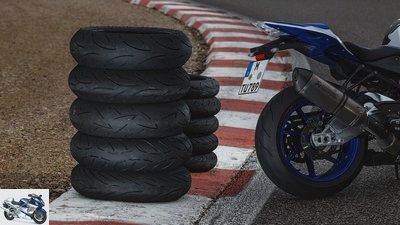
Jorg Kunstle
accesories
tire
Tire tips: usage, age, storage
Tire tips
Use, age, storage
Motorcycle tires are black, round and extremely important as the only contact areas with the road. Accordingly, they should be given sufficient attention.
Uli Baumann
March 24, 2020
There are those, the little runners, grandfather clocks or garage finds that have their tires flat. Or the bikers who have tires in stock so that they are always ready. The same questions arise again and again: How long can I use a tire before it has to be replaced? How do I have to store tires? How long is a tire considered new??
Store tires correctly
The aging of tires is a chemical and physical process that takes place slowly, provided that new (unused) tires are properly stored, explain the specialists at tire manufacturer Continental. Appropriate means: cool, dry, not exposed to direct sunlight, chemicals and the effects of ozone. Cool means in a temperature range of minus 20 to plus 25 degrees (racing tires should not be stored below 0 ° C). If tires are stored outside, they must be protected by an opaque waterproof film. In such a way that air can circulate and heat build-up is avoided. Tires without rims are stored upright, whereby a slight rotation is required at least every four weeks. Tires mounted on rims should be stored hanging as possible with an inflation pressure of one bar. Alternatively, they can also be stacked horizontally. Here, too, should be restacked every four weeks.
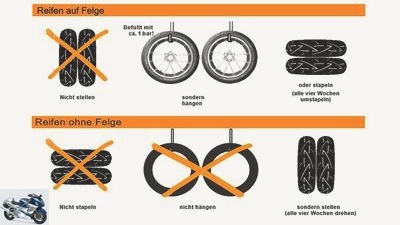
Continental
If these key points are correct, from a technical point of view an unused tire can be sold and used as a new tire up to five years after its production date. In the case of a new purchase, the date of purchase is the start of the warranty period. Anyone who comes across tires that are more than ten years old should definitely invest in new goods, no matter how good the old tire looks.
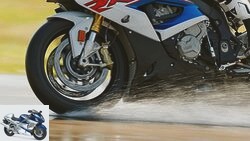
tire
The right choice of tires
Enduro, touring or sports tires?
read more
The DOT number reveals the age of the tire
The DOT number on the tire wall, which contains the production date, reveals how old a tire is. Usually, but not exclusively, the date marking follows the “DOT”-Marking of a manufacturer-specific alphanumeric string. The last four numbers indicate the production date of the tire. The first two of these numbers indicate the week of production (the range therefore ranges from “01 to “53”). The last two numbers represent the year of production. A tire with the marking “DOT XXXXXX2515” for example, was made in the 25th week of 2015.
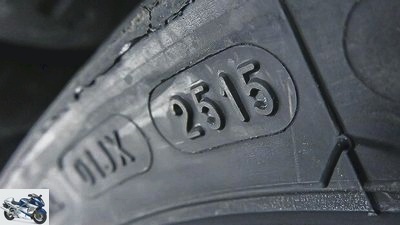
BILLION
Assess the tread depth correctly
Continental also has clear guidelines for the service life of a tire. It goes without saying that a tire is due when it reaches the legal minimum tread depth of 1.6 millimeters. If you want to stay on the safe side, change at the latest when the remaining tread depth is 2 mm. Measurements are made in the middle tread area and the minimum tread depth applies to all points in this area.
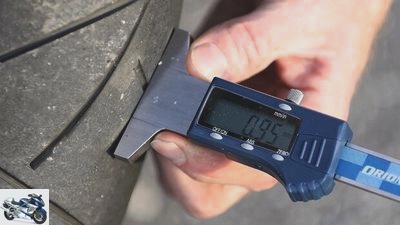
Markus Jahn
Modern tires are equipped with wear indicators (TWI = Tread Wear Indicator), which are integrated into the tread grooves at several points on the tire as crossbars, but they are useless as real wear indicators. As a rule, based on American standards, their height is only 0.8 mm and thus well below the minimum profile depth required in this country. By the way: A minimum tread depth of one millimeter applies to light mopeds, mopeds, mopeds and light motorcycles.
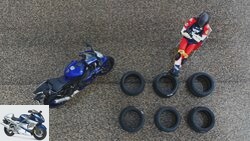
tire
6 sports tires (120/70 ZR 17; 190/55 ZR 17) in the test
2019 tires compared with the Yamaha YZF-R1
read more
Check for damage
The tread depth and age are not the only criteria for the useful life. Damage from punctures or cuts, joint fractures, cracks, dents, insufficient tire pressure or overload also limit the service life of the tire. Therefore, the tires should be subjected to regular visual inspections to detect any damage. If in doubt, a tire specialist should be contacted. Washed-out profiles also limit use. They usually draw attention to themselves through the changed running properties of the tire.
Small cracks are harmless
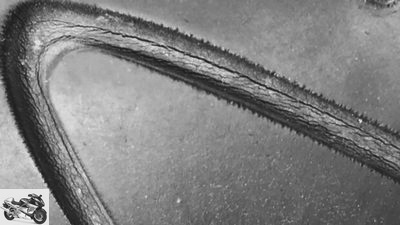
Continental
Cracks in the base of the tread (also called stress cracks) are usually caused by inadmissible air pressure, excessive heat, overloading of the tire or high ozone content in the area. Usually such cracks are purely superficial, no more than 0.5 mm deep and have no influence on the strength of the tire. From the point of view of the legislature, the technical monitoring organizations and the associations of the tire industry, such crack formation is generally considered to be harmless to operational safety. The properties of the tire are also unaffected.
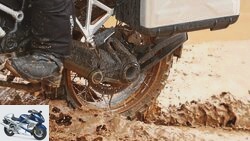
tire
2019 off-road tires for travel enduros in the test
For the compromise between terrain and road
read more
Here you can find all information on the topic Balancing and concentricity
Here you can find all information on the topic Tire labeling
There is even more tire information and the latest tire tests in the Rubric tires.
Related articles
-
PS reader question on motorcycle technology – tire wear on the racetrack
jkuenstle.de 5 pictures markus-jahn.com 1/5 “What is the reason for the flaky, frayed way in which racing tires are destroyed??”, asks us reader Holger…
-
Buying tip tire test part 3 large enduro tires Continental TKC 70
mps studio accesories tire Buying tip tire test part 3 large enduro tires Continental TKC 70 Buying tip tire test part 3 Continental TKC 70 Great mix of…
-
Fox accesories tire Understand tire labels What do the numbers and letters on a tire mean?? Understand tire labels A tire shows a lot of information…
-
Dunlop 14th pictures Dunlop 1/14 The Dunlop plant is located in Montluçon, France. Dunlop 2/14 125 years after its premiere, the pneumatic tire still…
-
www.jkuenstle.de 20th pictures www.jkuenstle.de 1/20 Under adverse conditions, i.e. wet, cold or the nasty combination of these two weather situations,…
-
Hypersport tire test 120-70 ZR 17 and 200-55 ZR 17
markus-jahn.com, r-photography.info, mps photo studio 18th pictures markus-jahn.com, r-photography.info, mps photo studio 1/18 Hypersport tires put to…
-
Enduro tires in the 2013 tire test
Jahn 44 pictures Jahn 1/44 Tire test 2013: 6 pairs of enduro tires: 110/80 R19, 150/70 R17. Jahn 2/44 Six enduro tires in country roads, wet conditions…
-
Driving tips: Warm up the motorcycle properly
jkuenstle.de counselor workshop Driving tips: Warm up the motorcycle properly This is how it works: Warm up the motorcycle properly How to get your bike…
-
MOTORRAD tire test 2016 – touring tires
markus-jahn.com 14th pictures markus-jahn.com 1/14 Picture gallery: Touring tires 120/70 ZR 17 and 180/55 ZR 17 in the test. markus-jahn.com 2/14 After…
-
New tire approvals for the ContiRoadAttack 3
Continental accesories tire New tire approvals for the ContiRoadAttack 3 New tire approvals for the ContiRoadAttack 3 From Aprilia to Yamaha Tire…